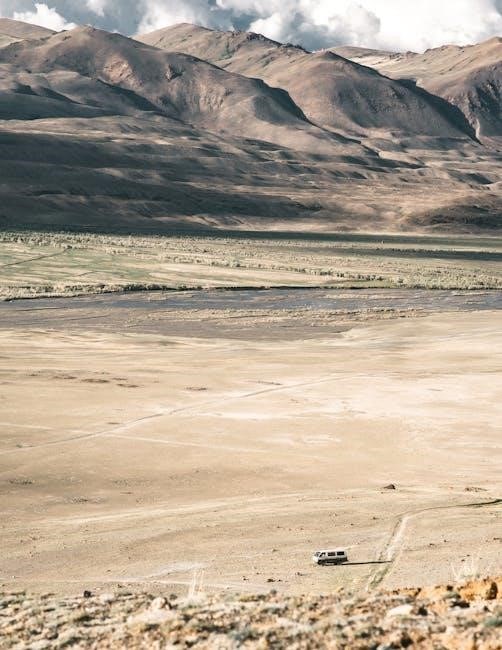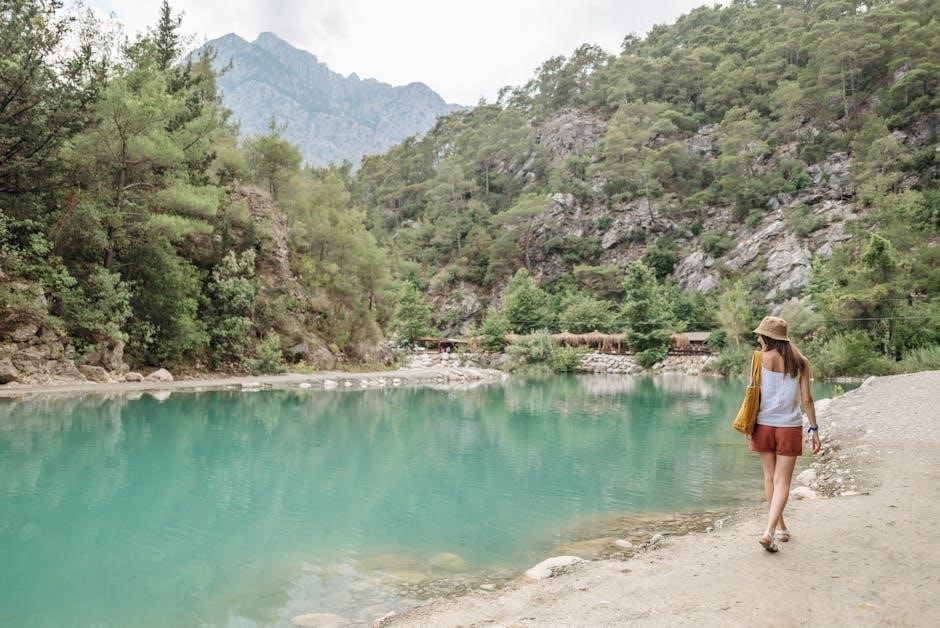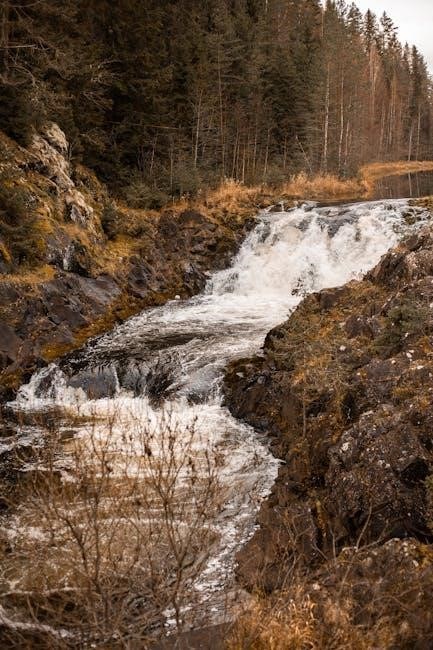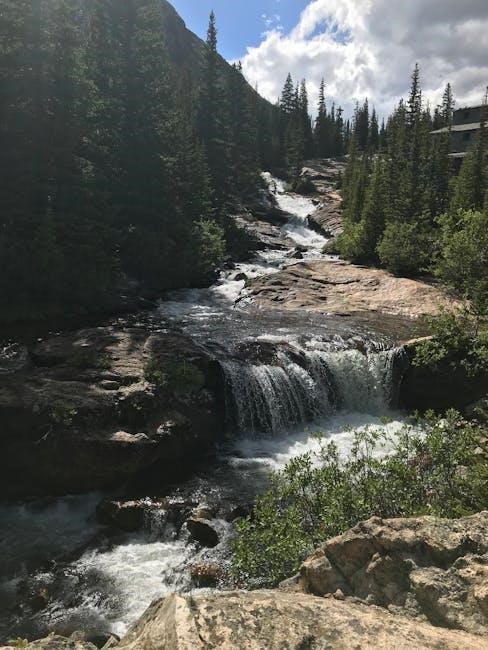
The New River Trail is a 57-mile linear state park and National Recreational Trail, offering scenic views, historic sites, and diverse outdoor activities along its route.
1.1 Overview of the Trail
The New River Trail is a 57-mile linear park offering scenic views, historic sites, and outdoor activities. It follows the New River for 39 miles, with sections along Chestnut Creek and Claytor Lake. Ideal for hiking, biking, and horseback riding, the trail is built on an old rail bed, providing a historic and picturesque experience. Maps in PDF, Illustrator, and Photoshop formats are available for planning.
1.2 Importance of the Trail Map
A trail map is essential for navigating the New River Trail, detailing its 57-mile route, access points, and amenities. It highlights scenic landmarks, tunnels, bridges, and resources like parking and restrooms. Available in PDF, Illustrator, and Photoshop, the map ensures visitors can plan their route effectively, whether hiking, biking, or exploring historical sites along the trail.
Key Features of the New River Trail
The New River Trail spans 57 miles, offering a mix of scenic views, tunnels, and bridges. It parallels the historic New River, providing a unique outdoor experience.
2.1 Length and Geography
The New River Trail stretches 57 miles, following the historic New River for 39 miles, with additional segments along Chestnut Creek and Claytor Lake. The trail traverses rolling pastures, scenic valleys, and diverse landscapes, offering a varied geographical experience. Its conversion from an old rail bed provides a flat, accessible path for exploration, enhancing its appeal as a multi-use trail.
2.2 Tunnels, Bridges, and Scenic Views
The trail features numerous tunnels, including the iconic 193-foot Hiwassee Tunnel, and over 30 bridges offering dramatic views of rivers and valleys. Scenic overlooks provide perfect spots to photograph the surrounding landscape, while the trail’s diverse terrain ensures a visually rewarding experience for hikers, bikers, and horseback riders alike, enhancing its natural charm and recreational appeal.
History of the New River Trail
The New River Trail is built on the old rail bed of the Norfolk and Western Railway, repurposed for outdoor recreation. The New River, despite its name, is one of the world’s oldest rivers, offering a rich historical backdrop for the trail’s development and significance.
3.1 Background and Development
The New River Trail was developed from the former Norfolk and Western Railway corridor, transforming it into a multi-use path. The trail’s creation aimed to preserve the region’s history while promoting outdoor activities like hiking, biking, and horseback riding. Its development involved converting rail beds into a continuous path, ensuring accessibility and scenic exploration for visitors.
3.2 Historical Significance of the New River
The New River, despite its name, is one of the world’s oldest rivers, second only to the Nile. Its enduring flow has supported human activity for centuries, shaping local economies and cultures. Historically, it facilitated trade and transportation, connecting communities and fostering regional development, making it a cornerstone of the area’s heritage and identity.

Downloading the New River Trail Map PDF
Visit the National Park Service cartography site to download official maps in PDF, Illustrator, or Photoshop formats. The free NPS app also offers an interactive map.
4.1 Sources for Official Maps
Official New River Trail maps are available from the National Park Service cartography site and the Virginia Department of Conservation and Recreation. The NPS app provides interactive maps, while TrailLink offers detailed trail descriptions and amenities. These sources ensure accurate and up-to-date information for planning your visit to the New River Trail State Park.
4.2 Formats Available (PDF, Illustrator, Photoshop)
The New River Trail map is available in PDF, Illustrator, and Photoshop formats, ensuring accessibility for various needs. PDFs are ideal for easy viewing and printing, while Illustrator and Photoshop files cater to users requiring detailed edits or professional use. These formats can be downloaded from the National Park Service cartography site and the Virginia Department of Conservation and Recreation, offering flexibility for different purposes.
Trail Segments and Amenities
The New River Trail is divided into 16 segments, ranging from 1.2 to 6.4 miles, with amenities like benches, picnic tables, and restrooms available throughout the trail.
5.1 Division of the Trail into Manageable Sections
The New River Trail is thoughtfully divided into 16 distinct sections, each varying in length from 1.2 to 6.4 miles. This segmentation allows visitors to plan their outings according to their preferences and fitness levels, ensuring a more enjoyable and manageable experience along the 57-mile trail.
5.2 Facilities Along the Trail
Benches, picnic tables, and restrooms, including vault toilets and porta-potties, are strategically placed throughout the trail for visitor convenience. These amenities ensure a comfortable experience, allowing hikers, bikers, and horseback riders to rest and recharge as they explore the scenic New River Trail.
Recreational Activities on the Trail
The New River Trail offers a variety of activities, including hiking, biking, and horseback riding, as well as camping, canoeing, and fishing opportunities along its scenic path.
6.1 Hiking, Biking, and Horseback Riding
The New River Trail is a multi-use path perfect for hiking, biking, and horseback riding. Its smooth surface and gentle grade make it accessible for all skill levels. The trail’s diverse terrain, ranging from riverside paths to rolling pastures, offers varied experiences for outdoor enthusiasts. With designated areas and parking for horse trailers, it’s an ideal spot for equestrians. Plan your adventure with the trail map to explore its full potential.
6.2 Camping, Canoeing, and Fishing Opportunities
The New River Trail offers excellent opportunities for camping, canoeing, and fishing. Campers can stay overnight at designated sites along the trail, while canoeists enjoy the calm waters of the New River. Fishing enthusiasts will find abundant species like trout and bass in the river. The trail map highlights access points and facilities, making it easy to plan your outdoor adventure.
Geological and Historical Highlights
Explore the ancient New River, one of the world’s oldest, and discover historical tunnels and bridges along the trail, offering a glimpse into its rich heritage.
7.1 Unique Geological Features
The New River Trail features stunning geological formations, including ancient riverbeds and unique rock layers. The trail’s path reveals the region’s tectonic history, with exposed cliffs and natural springs adding to its scenic beauty. These features make the trail a fascinating destination for geology enthusiasts and nature lovers alike to explore and appreciate.
7.2 Historical Sites Along the Trail
The New River Trail passes through several historical sites, including old railroad tunnels and bridges, showcasing the region’s industrial past. The trail also offers insights into the river’s role in shaping the area’s history, with remnants of early settlements and transportation routes still visible. These sites provide a glimpse into the cultural and historical significance of the New River Valley.

Scenic and Photographic Opportunities
The New River Trail offers stunning views of the river, tunnels, and bridges, with iconic landmarks providing perfect spots for capturing memorable photos and scenic moments.
8.1 Iconic Landmarks and Views
The New River Trail features iconic landmarks like the century-old trestle bridges and historic tunnels. Scenic overlooks provide breathtaking views of the river and surrounding valleys. The trail’s diverse landscape, including rolling pastures and forested areas, offers photographers a wide range of natural beauty to capture. These landmarks are highlighted on the official trail map, guiding visitors to the most picturesque spots.
8.2 Best Spots for Photography
The New River Trail offers stunning photography opportunities, with trestle bridges, tunnels, and riverside views. Scenic overlooks and sunlit valleys provide perfect backdrops. Capture the serene beauty of the river at sunrise or sunset for breathtaking shots. The trail map highlights these spots, making it easy for photographers to plan their visits and find the most photogenic locations along the route.
Safety Tips and Precautions
Be cautious in tunnels and bridges, ensuring visibility. Watch for wildlife, plan your time, and check weather forecasts. Familiarize yourself with the map for emergency exits.
9.1 Trail Safety Guidelines
Always carry a map and know your location. Be cautious in tunnels and bridges, ensuring visibility. Watch for wildlife and plan your time according to daylight. Check weather forecasts and avoid trail use during heavy rain. Stay alert for trail obstacles and follow posted rules. Keep children and pets close. Use proper lighting when biking and respect other trail users to ensure a safe experience for everyone;
9.2 Emergency Preparedness
Carry a map, water, snacks, and a first aid kit. Inform someone of your itinerary and expected return time. Familiarize yourself with trail markers and emergency access points. Bring a charged phone or communication device. Be prepared for changing weather conditions and know the location of nearest facilities. Stay visible and aware of surroundings to ensure prompt assistance if needed.
Wildlife and Birdwatching
The New River Trail offers abundant wildlife viewing opportunities, with native species and diverse bird populations. Birdwatching hotspots include Storm Ranch and Floras Lake, perfect for spotting rare species.
10.1 Native Species and Wildlife Viewing
The New River Trail is a haven for wildlife enthusiasts, offering sightings of native species like deer, rabbits, and foxes. Birdwatchers can spot herons, eagles, and migratory birds. The trail’s diverse habitats, including forests and wetlands, support a wide range of flora and fauna, making it a prime location for nature observation and photography.
10.2 Birdwatching Trails and Hotspots
The New River Trail offers exceptional birdwatching opportunities, with hotspots along the river and wetlands. Birders can spot species like herons, eagles, and migratory birds. Designated birding trails and scenic overlooks provide ideal vantage points. The trail’s diverse habitats attract a wide variety of avifauna, making it a must-visit destination for bird enthusiasts and nature lovers alike.

Parking and Access Points
Parking lots are located at key access points like Cliffview, Draper, Fries, Foster Falls, Allisonia, and Pulaski, offering convenient entry to the trail for visitors.
11.1 Main Entrances and Parking Lots
The New River Trail features several main entrances with designated parking lots, including Cliffview, Draper, Fries, Foster Falls, Allisonia, and Pulaski. These lots provide easy access to the trail, with amenities like restrooms and picnic areas nearby. The 57-mile trail is a linear park, making these entry points ideal for hikers, bikers, and horseback riders to start their adventure.
11.2 Access for Horse Trailers
Horse trailers have designated parking areas at specific lots, including Cliffview, Draper, Fries, Foster Falls, Allisonia, and Pulaski. These locations are equipped to accommodate larger vehicles, making it convenient for equestrians to access the trail. The parking areas are strategically spaced along the 57-mile trail, ensuring easy entry and exit for horseback riders and their equipment.

Nearby Attractions and Accommodations
Nearby attractions include surrounding state parks and protected areas, offering camping, canoeing, and fishing opportunities. Local accommodations range from cozy lodges to charming inns, conveniently located near trailheads.
12.1 Surrounding State Parks and Protected Areas
The New River Trail is surrounded by several state parks and protected areas, including Storm Ranch, Floras Lake, Fourmile Creek, and Lost Lake. These areas offer diverse trails for hiking, biking, and horseback riding, providing opportunities to explore unique ecosystems and scenic landscapes; The parks are well-integrated with the trail, enhancing the overall outdoor experience for visitors.
12.2 Local Accommodation Options
Visitors to the New River Trail can choose from a variety of local accommodations, including cozy cabins, bed-and-breakfast inns, and campgrounds. Many options are located near trail access points, offering convenient stays for outdoor enthusiasts. Towns like Pulaski and Galax provide charming lodging choices, with amenities such as restaurants and gear storage, making them ideal bases for exploring the trail and surrounding areas.
Regulations and Rules
The New River Trail enforces rules to ensure safety and conservation, including yielding to other trail users, staying on designated paths, and properly disposing of waste.
13.1 Trail Usage Rules
The New River Trail is a multi-use path for hiking, biking, and horseback riding. Users must stay on designated trails, yield to horses and hikers, and follow speed limits (15 mph for bikers). Pets must be leashed, and motorized vehicles are prohibited. Respect wildlife, and avoid alcohol consumption. Stay alert and courteous to ensure a safe experience for all trail users.
13.2 Environmental Conservation Guidelines
To protect the New River Trail’s natural beauty, visitors must keep the trail clean by packing out trash and avoiding litter. Stay on designated paths to prevent erosion and protect sensitive habitats. Do not disturb wildlife or remove plants. Follow “Leave No Trace” principles to preserve the environment. Respect river access rules and avoid polluting water sources. Camping and fishing should be done responsibly, adhering to local regulations.